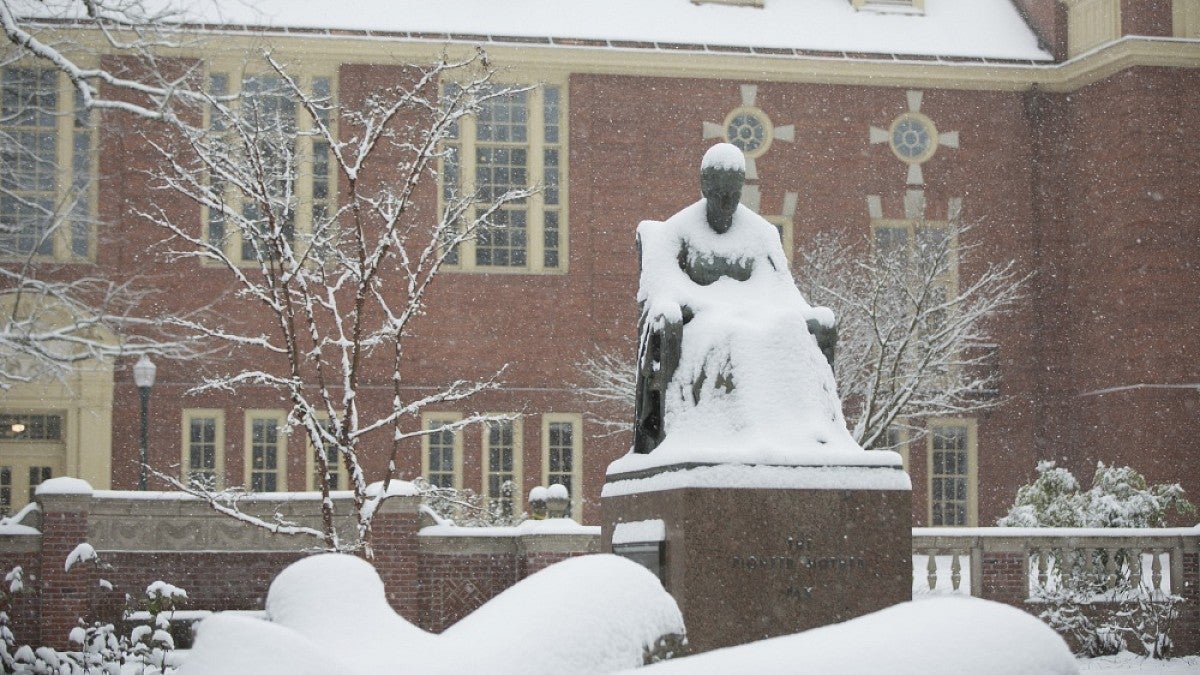UO employees and students need to be ready for hazardous weather anytime from about November through March, and a critical part of that is knowing how closure and delay decisions are made and how information about inclement weather is shared.
If getting around campus is safe and most employees and students have ways to get safely to campus, then the UO will most likely operate normally. The UO’s policy states that decisions will often be different from those of other area schools, governments and universities.
When the UO’s incident management team and administrators determine that campus is not safe, or when local conditions are extremely severe around campus, the UO can choose from three types of closures:
Delayed opening: Classes and events are canceled and all nonessential administrative and academic activities are suspended at the Eugene campus until a designated opening time.
Early closure: Classes and events are canceled and all nonessential administrative and academic activities are suspended at the Eugene campus at a designated closing time.
Full closure: All classes and events are canceled and all university offices and departments are closed except select emergency and essential services.
Some research, facilities and housing operations will always operate. Employees who perform essential functions will be expected to work if they can do so safely. Employees who aren’t sure if their functions are designated as essential should ask their supervisors. But it is understood that not everyone may be able to travel to campus due to inclement weather, even if the UO is open.
Members of the campus community are expected to use their best judgment in assessing the risk of coming to campus, based on individual circumstances and in consultation with supervisors or instructors. UO leaders ask instructors and supervisors to be flexible in working with people who choose not to come for their own safety.
Under the UO’s comprehensive weather monitoring and decision-making protocol, Safety and Risk Services staff work with the National Weather Service to get early weather warnings. The UO’s incident management team monitors local conditions and checks with other local agencies like the cities of Eugene and Springfield, Lane Transit District, the Oregon Department of Transportation and local school districts.
Campus staff also check road and path conditions and report to the incident management team, whose leaders convene with UO administrators to decide whether to operate normally, delay opening, close early or close fully.
The main variables in the decision are: Is campus safe, are the UO-designated winter weather roadways and paths navigable, are buildings safe to enter, are there hazards like falling trees and do buildings have power, water and heat? The team also considers what is happening in the community, whether people are being told to stay home and whether LTD is operating.
Being a residential and research campus, the UO has many functions that go on regardless of weather, including complex academic and research schedules that would be disrupted by cancellations and 4,000 students who live on campus and many others who live within safe and easy walking distance.
The UO suggests several tools employees and students can use to be aware, prepared and resilient in hazardous weather:
- UO Alerts: Official communication of any changes to the university’s schedule comes through UO Alerts texts and emails. All employees and students should make sure current mobile numbers are activated to receive UO Alerts text messages in all emergencies, including weather situations. Manage UO Alerts at duckweb.uoregon.edu. Emails come to all uoregon.edu accounts.
- UO Alerts blog: Includes all UO Alerts messages but also will share extra information on known hazards and resources for safety and information. The best UO source for ongoing and detailed information.
- UO inclement weather route map.
- Human resources: A web page on inclement weather explains how employees may be paid or use leave depending on institutional status, employee classification or individual decisions.
- UO policy on closure of facilities and operations.
- Winter tips: The right clothing, footwear and even tactics for walking can be the difference between safety and serious injuries.
- Winter driving tips and resources from the Oregon Department of Transportation and National Weather Service.


